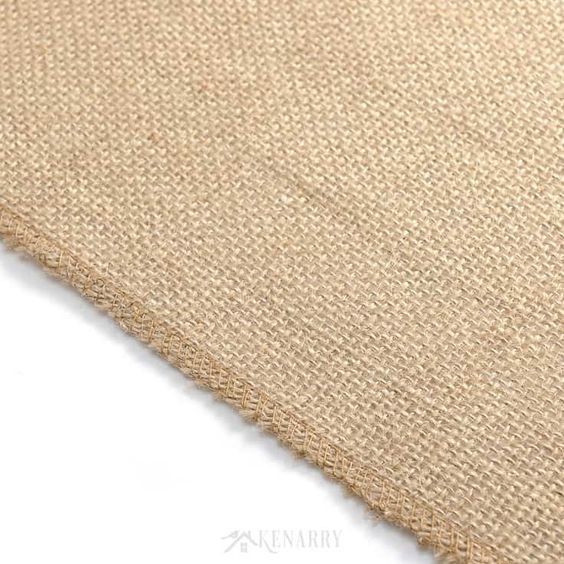Jute fabric, often recognized as burlap or hessian cloth, is a natural textile fiber extracted from the jute plant. Predominantly derived from Corchorus olitorius (white jute) and the superior Corchorus capsularis (tossa jute), jute holds the position as the second most produced plant-based fiber globally, following cotton. While its presence in Western markets may be less prominent, jute remains a vital textile resource in India and neighboring nations.
Grown in conditions similar to rice, jute plants flourish in warm, monsoon-prone areas, reaching heights exceeding 10 feet. One of the unique characteristics of jute is its fiber, which is harvested as a single, long strand, classifying it among the longest natural textile fibers available.
The Historical Significance of Jute
The cultivation and usage of jute date back at least 5,000 years on the Indian subcontinent, with evidence suggesting its presence around 3000 BC. Jute played a crucial role in the socio-economic development of Indian society for millennia, even before the rise of European colonialism.
During British involvement in India, jute became a key cash crop, fueling colonial endeavors. While Scotland also had a history of jute production, Bengal and other Indian regions soon surpassed it. The lucrative jute trade attracted Scottish producers to emigrate to India to capitalize on the jute boom.
Jute remained a significant economic driver for the British Empire until the late 19th century. Post-Indian independence, it continued as a major export. However, the emergence of synthetic fibers in the late 20th century led to a decline in jute production, which only resurged in the early 21st century, regaining its economic importance in Bengal, Bangladesh, and other parts of the Indian subcontinent.
Jute Fabric: Properties and Applications
Jute is known for its rough texture, making it ideal for industrial applications rather than apparel, unless extensively processed. Its durability, combined with a loose weave of thick yarn, makes it a practical choice for various uses.
The fabric absorbs water readily and dries quickly, offering resistance to abrasion and stains. As a plant-based material, jute is biodegradable, though it may not be suitable for long-term outdoor use. It is mostly light brown, with some off-white varieties available, the latter being considered less durable but potentially more suitable for clothing.
Jute’s thickness and pliability make it easy to handle, and its long, shiny fibers simplify yarn manufacturing. Highly breathable with medium heat retention, jute is suitable for apparel in hot, humid climates.
The Manufacturing Process of Jute
The production process for jute fabric has remained largely unchanged over centuries. Mature jute stalks are harvested by hand and defoliated. The fibers are extracted from both the inner stem and outer skin.
Retting, a process of soaking the stalks, softens them to allow manual separation of the fibers from the unusable material. These fibers are then combed into long strands and spun into yarn, often using traditional spinning wheels.
The yarn may undergo chemical treatments for dyeing, water resistance, or fire resistance. Finally, the finished jute fiber is shipped to textile production facilities to be woven into various products. For apparel, softening techniques are employed to enhance comfort.
Diverse Uses of Jute Fabric
While not typically used for clothing due to its rough texture, recent advancements have made jute suitable for certain garments. Jute sweaters and light jackets are becoming increasingly popular.
Traditionally, jute is synonymous with burlap, a widely used industrial material for sacks to transport goods and as an insulation material. Its agricultural uses include erosion prevention in jute and rice fields and protective wrappings for sapling roots, allowing for natural root penetration due to its biodegradability.
Jute is also used in flooring applications, such as the backing for linoleum tiles, rugs, and carpets. In homeware, it’s used for upholstery, particularly outdoor furniture, curtains, and canvas. Interestingly, it is a key component of ghillie suits, providing effective camouflage in foliage-rich environments.
Global Production and Cost of Jute
India, Bangladesh, and Pakistan are the primary jute producers, with 85% of the production concentrated in the Ganges River Delta. China also ranks as a significant producer, along with other Asian countries like Thailand, Burma, and Bhutan.
China is the largest market for textiles, including jute. While much of the jute market remains in Asia, countries like India and Bangladesh export jute to the United States, the European Union, and other markets worldwide.
Jute fabric is among the least expensive textiles, typically costing around $1 per yard, comparable to cotton. Purchasing directly from manufacturers in India, Bangladesh, or other jute-producing countries can be the most economical and can support local economies.
Varieties of Jute Fabric
Though two main varieties exist, there are a few other types of jute:
-
White Jute: Once popular, now less common. Historically used for clothing in Bengal, it is lighter in color but less durable than other types.
-
Tossa Jute: The most common type in production today. It is a hardy crop yielding more fiber, with a brownish color and strong, long fibers.
-
Mesta Jute: A hybrid of white and tossa jute, it gained prominence due to political factors during India’s independence period.
- Jute Cuttings: Byproducts of jute production, these are the roughest parts of the plant but can still be used for basic textiles.
Environmental Impact of Jute
Jute has a generally positive environmental impact. Unlike many other natural fibers, it offers environmental benefits.
Grown in similar areas as rice, jute helps replenish soil nutrients and retain moisture, counteracting the soil depletion caused by rice cultivation. This makes jute and rice symbiotic crops, diminishing the environmental impact of rice farming.
Sustainable cultivation practices, such as crop rotation, are essential to prevent soil damage. While jute production typically doesn’t require chemical fertilizers or pesticides, their use can negate its environmental benefits.
Post-Production Environmental Impact
Jute, as a natural textile fiber, is biodegradable, preventing environmental accumulation and the release of microfibers. Its disposal methods, including burning, have minimal environmental impact, unlike synthetic fibers that release toxins or persist in landfills.
Humanitarian Concerns in Jute Production
Potential harm in jute production lies in its impact on local economies. While many jute producers in Bangladesh and other areas are independent and locally-owned, corporate-owned facilities may extract value without reinvesting in the community. This can hinder environmental stewardship and encourage unsustainable practices.
Purchasing jute from independent companies with strict organic environmental stewardship protocols is crucial to support ethical production and prevent worker exploitation.
Jute Fabric Certifications
As a plant-based fiber, jute is eligible for organic certification from agencies like the U.S. Department of Agriculture and the European Union’s organic certification agency. However, given that most jute is grown outside these regions, these certifications are less relevant.
SGS also provides certification services for jute fiber, focusing on quality and grade rather than organic certification.

